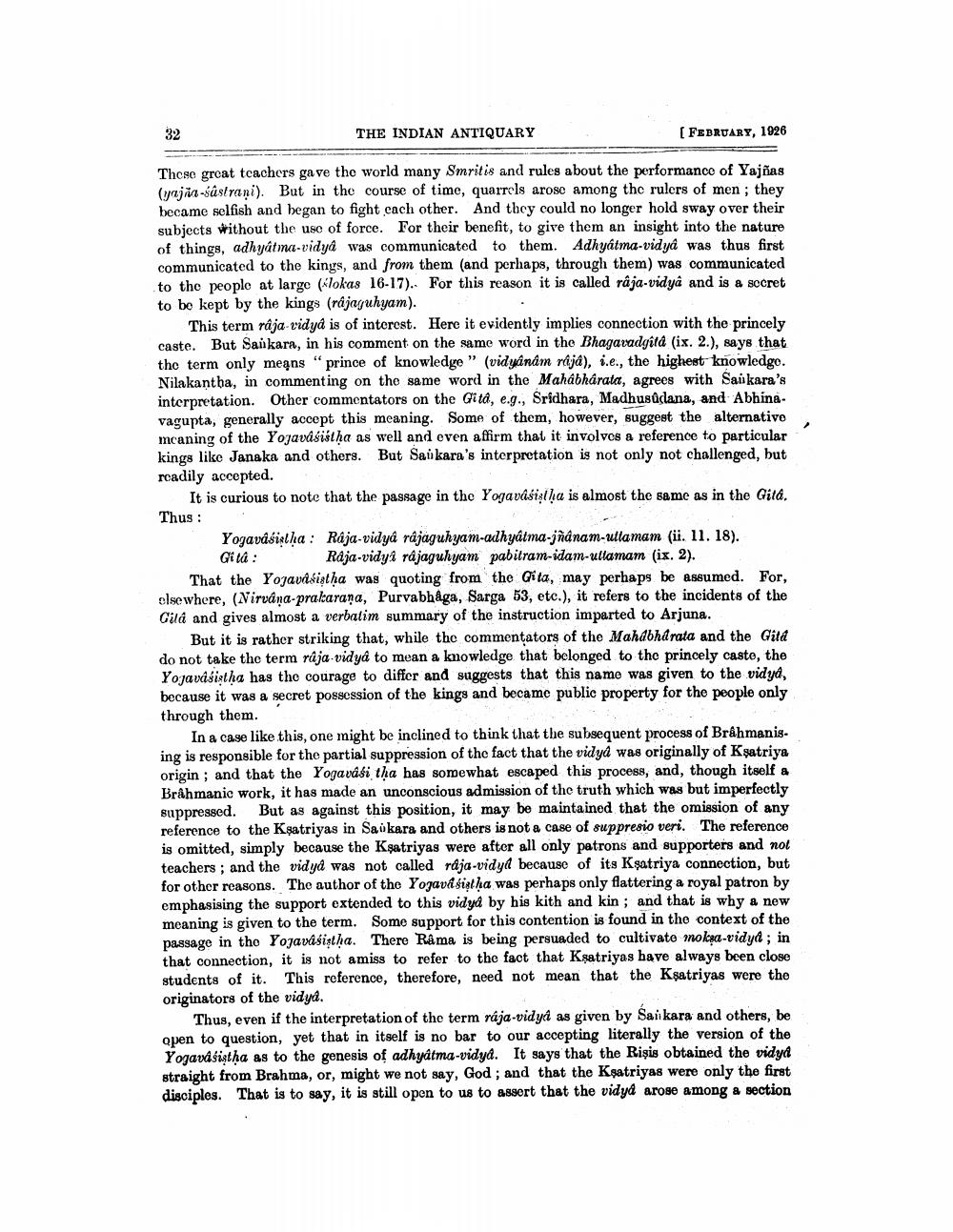________________
THE INDIAN ANTIQUARY
(FEBRUARY, 1926
These great teachers gave the world many Smritis and rules about the performance of Yajñas (yajan-sâstrani). But in the course of time, quarrels arose among the rulers of men ; they became selfish and began to fight cach other. And they could no longer hold sway over their subjects without the use of force. For their benefit, to give them an insight into the nature of things, adhyatma-vidyê was communicated to them. Adhyatma-vidyê was thus first communicated to the kings, and from them (and perhaps, through them) was communicated to the people at large (lokas 16-17). For this reason it is called råja-vidya and is a socret to be kept by the kings (rajaguhyam).
This term raja-vidyd is of interest. Here it evidently implies connection with the princely caste. But Sankara, in his comment on the same word in the Bhagavadgita (ix. 2.), says that the term only means "prince of knowledge” (vidyanam raja), i.e., the highest knowledgo. Nilakantha, in commenting on the same word in the Mahabharata, agrees with Sai kara's interpretation. Other commentators on the Gità, e.g., Sridhara, Madhusaclana, and Abhina. vagupta, generally accept this meaning. Some of them, however, suggest the alternative meaning of the Yojavasistha as well and even affirm that it involves a reference to particular kings like Janaka and others. But Sau kara's interpretation is not only not challenged, but readily accepted.
It is curious to note that the passage in the Yogavasiştha is almost the same as in the Gita. Thus :
Yogavasisha: Raja-vidya rajaguhyam-adhyatma-jñanam-ullamam (ii. 11. 18).
Gita: Raja-vidyi rajaguhyam pabilram-idam-ullamam (ix. 2). That the Yojavišiştha was quoting from the Gita, may perhaps be assumed. For, olsewhere, (Nirvana-pralarana, Purvabhaga, Sarga 53, etc.), it refers to the incidents of the Gild and gives almost a verbatim summary of the instruction imparted to Arjuna.
But it is rather striking that, while the commentators of the Mahabhdrata and the Gita do not take the term raja-vidya to mean a knowledge that belonged to the princely caste, the Yojavasistha has the courage to differ and suggests that this name was given to the vidya, because it was a secret possession of the kings and became public property for the people only through them.
In a case like this, one might be inclined to think that the subsequent process of Brahmanising is responsible for the partial suppression of the fact that the vidyd was originally of Ksatriya origin; and that the Yogavasi tha has somewhat escaped this process, and, though itself & Brahmanic work, it has made an unconscious admission of the truth which was but imperfectly suppressed. But as against this position, it may be maintained that the omission of any reference to the Ksatriyas in Savkara and others is not a case of suppresio veri. The reference is omitted, simply because the Ksatriyas were after all only patrons and supporters and not teachers; and the vidyd was not called råja-vidyd because of its Ksatriya connection, but for other reasons. The author of the Yogava sistha was perhaps only flattering a royal patron by emphasising the support extended to this vidyd by his kith and kin; and that is why a new meaning is given to the term. Some support for this contention is found in the context of the passage in the Yojavasixtha. There Rama is being persuaded to cultivate mokra-vidya ; in that connection, it is not amiss to refer to the fact that Ksatriyas have always been close students of it. This reference, therefore, need not mean that the Ksatriyas were the originators of the vidya.
Thus, even if the interpretation of the term rája-vidyd as given by Sai kara and others, be open to question, yet that in itself is no bar to our accepting literally the version of the Yogavdśistha as to the genesis of adhyatma-vidyd. It says that the Rigis obtained the vidya straight from Brahma, or, might we not say, God, and that the Ksatriyas were only the first disciples. That is to say, it is still open to us to assert that the vidyd arose among a section




